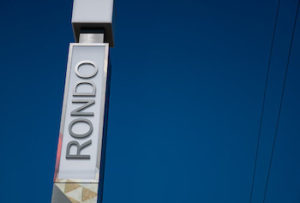
Rondo Plaza (sign)
*The Rondo community c. 1880 is celebrated on this date. St. Paul, Minnesota’s Rondo community was a haven for Black and Brown people, as well as immigrants.
The community celebrates its heritage (Rondo Days) annually on the 3rd Saturday in July. Its namesake, Joseph Rondeau, moved there in the late 1850s from near Fort Snelling. At the fort, he and his Native American wife were racially abused. French Canadian immigrants followed Rondeau to the area in the late 19th century; later, German, Russian, Irish, and Jewish families also settled in the area.
By the 1930s, Rondo was the heart of St. Paul’s Black community, not only housing the majority of Black residents in the city but also home to critical community businesses, organizations, and institutions such as the Pilgrim Baptist Church, the Hallie Q. Brown Community Center, the Sterling Club, and St. Peter Claver Church. However, by the late 1950s, this tight-knit community would be shattered by the construction of Interstate 94, which connected the downtown business corridors of Minneapolis and St. Paul—the initial expressway plan for the Minneapolis-St. Paul Paul area. Paul's connection was known as the St. Anthony Route, which followed St. Anthony Avenue (parallel to University Avenue) and extended directly through the heart of the Rondo neighborhood.
St. Paul City Engineer George Harold opposed this plan, citing concerns about the loss of land for local use and the dislocation of people and businesses, suggesting the alternative Northern Route, which would run adjacent to railroad tracks north of St. Anthony Avenue, leaving the street intact. Ultimately, government officials chose and approved the St. Anthony Route, citing its efficiency. In 1955, Rondo community leaders Reverend Floyd Massey and Timothy Howard worked to lessen the effects of freeway construction and gain support for a new housing ordinance by forming the Rondo-St.. Anthony Improvement Association.
Their advocacy successfully achieved a depressed (below-grade) construction of I-94. However, the route still split the Rondo neighborhood, forcing hundreds of people and businesses to evacuate and relocate. One in every eight Blacks in St. Paul lost a home to I-94. Many businesses never reopened. Although the physical community was permanently damaged and changed, the spirit of Rondo lives on.
In 1983, the first annual Rondo Days festival was held in July, celebrating the community's history and continuing legacy. The experience of Rondo and I-94 was also frequently cited and discussed as a cautionary tale, informing and impacting the construction of the Green Line light rail service connecting St. Paul and Minneapolis, which opened to the public in 2014. In 2018, Rondo Plaza was built to preserve the Rondo community openly.